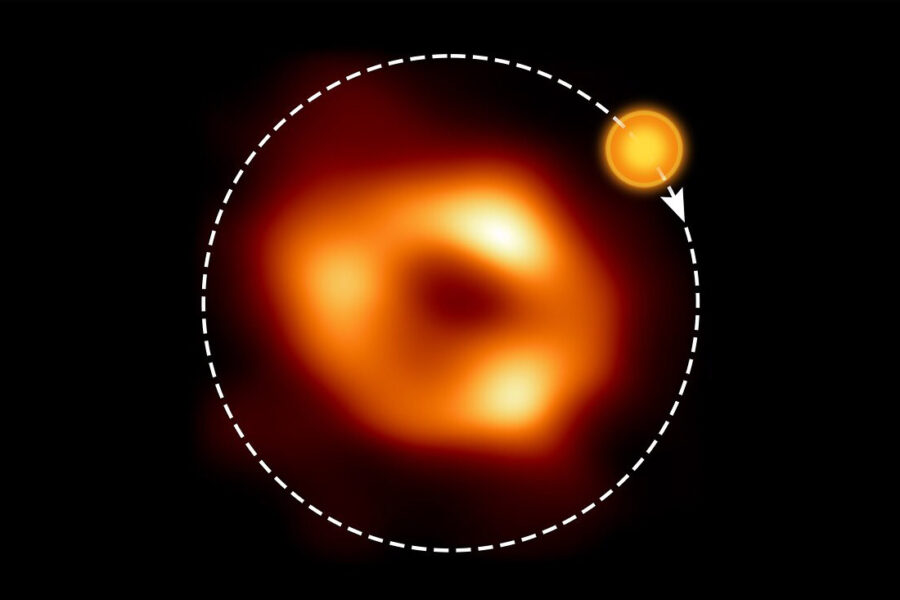Astronomers have detected a bubble of hot gas circling our galaxy’s central black hole soon after seeing a flare, suggesting both arose from the same process.
Earlier this year, the Event Horizon Telescope collaboration unveiled its long-awaited image of the shadow of our galaxy’s supermassive black hole, Sagittarius A*. But this monumental achievement isn’t the only boon the EHT brings to astronomy. The observations also gave scientists a unique opportunity to probe what happens around a black hole.

EHT Collaboration, ESO / M. Kornmesser (Acknowledgment: M. Wielgus)
EHT researchers reconstructed the Danish-pastry-like image using observations taken in April 2017 by radio instruments spread across the Western Hemisphere. As part of the observing campaign, astronomers also studied Sgr A* at X-ray, near-infrared, and additional radio wavelengths across several days. On April 11th, two of those X-ray observatories caught something exciting: a nice big flare.
The flare itself wasn’t unusual: Sgr A* flares daily in both X-rays and infrared, sometimes boosting its own brightness a hundredfold. And many black holes unleash flares, presumably powered by sudden changes in the hot, magnetized gas spiraling down the spacetime drain (we’re not quite sure). What was unusual was that so many observatories were watching.
Conducting simultaneous observations with a suite of telescopes on the ground and in space is a logistics nightmare, and it’s tough to secure time slots that overlap perfectly. Infuriatingly, the EHT array missed the flare by a mere half hour. (If you ever want to see astronomers yank their hair out in dismay . . .) But the EHT did catch an uptick in how much the radio emission varied right after the flare.
Maciek Wielgus (Max Planck Institute for Radio Astronomy, Germany) and other EHT scientists have now dug into data taken by ALMA in the hours after the flare. The observations capture the radio emission’s polarization, which is set by the magnetic field lines the photons are corkscrewing along. The polarization patterns thus tell us about what’s happening in the big tutu of gas surrounding the black hole.
The ALMA data reveal that the polarization rotated, tracing a big loop on the sky over about 70 minutes. This behavior likely signals the presence of a hotspot, a feverous gas bubble whizzing its way around the black hole in an orbit that lies in the innermost region of the accretion disk, the team explains in Astronomy & Astrophysics. (ALMA’s view isn’t sharp enough to resolve the actual hotspot in an image.) To complete the circuit so fast, the bubble must be traveling at about 30% the speed of light.

M. Wielgus et al. / Astronomy & Astrophysics 2022
Hotspots should arise naturally, as the magnetic fields threading the gas snap into new configurations. When this magnetic reconnection occurs, it releases energy, heating the surrounding gas. Reconnection is also the favored explanation for Sgr A*’s flares. So this circling hotspot, following so fast after the X-ray flare, may help confirm these outbursts have a magnetic origin.
Furthermore, because hotspots’ emission changes in appearance due to the conditions and orientation of the gas disk, the astronomers were able to use the hotspot to probe the gas flow’s nature. They infer that we’re looking at Sgr A*’s accretion disk nearly face on (tilted only 20° toward or away from our line of sight), and the disk is packed with magnetic field lines sticking up from the tutu like uncooked spaghetti. These inferences match not only those from the full EHT analysis but also ones from previous infrared observations.
You can read more about what the EHT has revealed about Sgr A* in S&T’s December issue. Not a subscriber? Click here to subscribe or give a subscription to someone else.
Reference:
M. Wielgus et al. “Orbital Motion near Sagittarius A*: Constraints from polarimetric ALMA observations.” Astronomy & Astrophysics. Published online September 22, 2022.
 0
0









Comments
You must be logged in to post a comment.